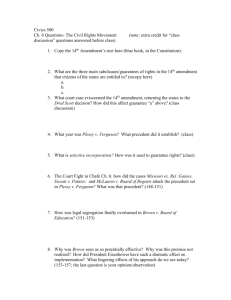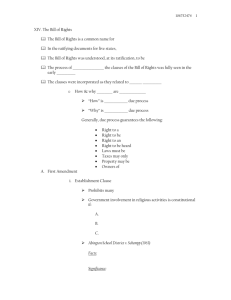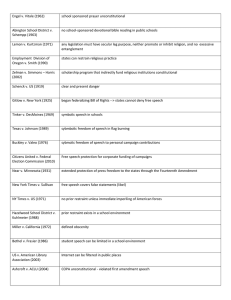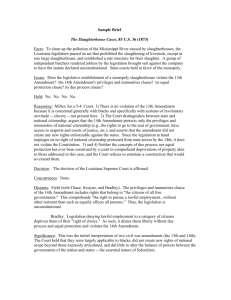Unit 1
advertisement
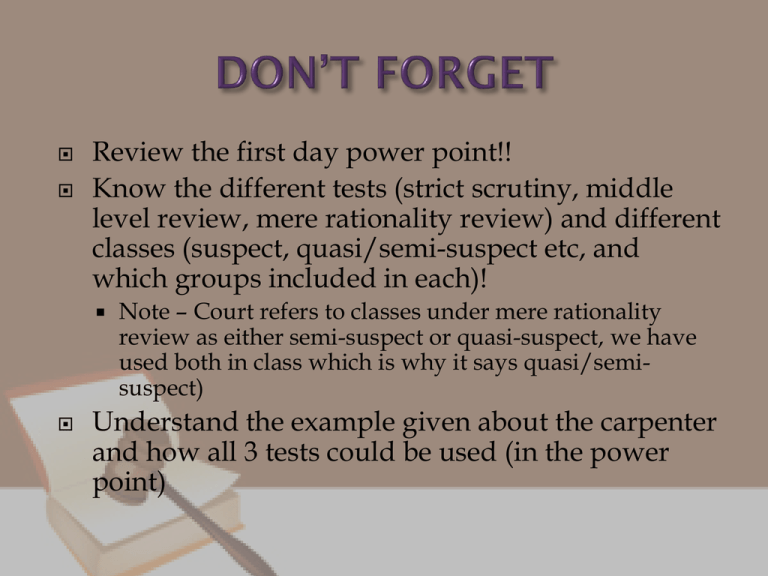
Review the first day power point!! Know the different tests (strict scrutiny, middle level review, mere rationality review) and different classes (suspect, quasi/semi-suspect etc, and which groups included in each)! Note – Court refers to classes under mere rationality review as either semi-suspect or quasi-suspect, we have used both in class which is why it says quasi/semisuspect) Understand the example given about the carpenter and how all 3 tests could be used (in the power point) Issue: Whether Scott could be a citizen of the US and therefore receive all protections of constitution? Whether Missouri compromise was unconstitutional? Decision: No; Yes. Significance: No longer good law, overturned by passing of 13, 14, 15 Amendments Precedent: NA Issue: Whether the Civil Rights Act of 1875 was unconstitutional (CRA made it a federal crime to deny on basis of race any individual’s equal access to inns, public transportation, and other public places of accommodations) Decision: Yes Significance: First time SC says 14th Amendment rights applicable only where state action is present. No longer good law, overturned in 1964 & 1965 by Civil Rights Act which included eating establishments and other public places of accomodations Precedent: NA Issue: Whether LA law violated the 14th Amendment? Decision: No Significance: This case formulated and upheld the “separate but equal” doctrine Precedents: Roberts v. City of Boston-ruled segregated schools were constitutional Issue: Whether the restrictive covenant, restricting the sale of homes to minorities, violated the equal protection clause of the 14th Amendment? Decision: Yes Significance: Still good law, you can have restrictive covenants, but they won’t be enforced by the Courts Precedent: NA Issue: Whether segregation of races in public schools violates the equal protection clause of the 14th Amendment? Decision: Yes, unanimous! Significance: Precedent: Sweatt v. Painter –ruled that segregated law schools were not equal because did not provide equal educational opportunities Issue: Whether the segregation of public schools based on race was a violation of the due process clause of the 5th Amendment? Decision: Yes Significance: Still good law, applied Brown v. BOE to the federal governments Precedent: Brown v. BOE Issue: How should Brown I be implemented? By when do schools need to be integrated? Decision: Schools must integrate “with all deliberate speed” Significance: Decision was apology for not setting precise guidelines as well as a recognition for the limitation of judicial power Precedent: Brown v. BOE Issue: Whether the multidistrict desegregation plan was an appropriate remedy to the de facto segregation in the Detroit area? Decision: No, it was not Significance: Still good law, court defines difference btwn de facto and de jure segregation. Not the job of the courts to fight de facto segregation, only de jure segregation. Precedent: Swann v. Charlotte-Mecklenburg— federal courts may not order a school board to adjust the racial composition of any of its schools unless there has been a finding that there was de jure segregation Issue: Whether University of California’s quota system used for admissions violated the equal protection clause of the 14th Amendment? Decision: Yes Significance: even though quota system unconstitutional, it upheld affirmative action, also noted that affirmative action plans subject to strict scrutiny Precedent: NA Issue: Whether law school’s consideration of race and ethnicity in its admissions decisions was a violation of the EP clause? Decision: No, was constitutional Significance: Law school’s best interest to create diverse student body, upheld Bakke, recognized benefits of affirmative action Precedent: Bakke Issue: Whether UM use of racial preferences in undergraduate admissions violates equal protection clause of 14th Amendment? (used point system, people assigned automatic 20 points) Decision: Yes, unconstitutional Significance: upheld Bakke but no factor can be solely based on race Precedent: Bakke, Grutter Remember 4 things we wrote down that help us in analyzing cases and state of law after Grutter & Gratz Race conscious admissions measures will receive strict scrutiny, and thus must be narrowly tailored to serve compelling objective Pursuit of diversity in student body can be compelling objective A one at a time student evaluation where race is merely one factor among various ones is sufficiently narrow Mechanical approaches resembling quotas such as automatically awarding an applicant a fixed number of points towards admissions based on race are not narrowly tailored and therefore violate EP Issue: Whether the Seattle school district’s policy of using race as a “tie breaker” to help determine which high school students should go to violates EP clause of the 14th Amendment. Decision: Yes, policy unconstitutional Significance: Affirmative action cannot be applied in school system with race as a determinative factor Precedent: Bakke, Gratz, Grutter Brief Facts: Woman in air force, husband had to prove he was dependent on her before he could get benefits, men in air force, their wives were presumed to be dependent Issue: Whether the difference in benefit treatments btwn men and women (for their spouses) violates due process clause of 5th Amendment? Decision: Yes, unconstitutional Significance: While gender given strict scrutiny in this case, court later settled on middle level review Precedent: Reed v. Reed – overturned a law that gave fathers of deceased mandatory preference over mothers in administering deceased estate bc gave preferences to males without regard to their individual qualifications Issue: Whether gender-based difference regarding sale of non-intoxicating beer constitutes a denial to males 18-20 years old of the EP of laws of 14th Amendment? Decision: Yes, unconstitutional Significance: Court permanently settled on intermediate level of scrutiny for gender-based classifications, regardless of whether they are benign. Precedent: NA Issue: Whether the statute denying welfare benefits to residents who have not resided in the state for at least one year violates 14th amendment equal protection clause? Decision: Yes, unconstitutional Significance: strict scrutiny applies to fundamental rights, right to travel is fundamental right Precedent: NA Issue: Whether the mentally retarded should be regarded as a quasi/semi-suspect class? Whether the city ordinance violated the EP clause of the 14th Amendment? Decision: No, mentally retarded not quasisuspect class; yes, city ordinance violated EP Significance: SC felt best way to protect the mentally retarded was to not classify them as quasi-suspect Precedent: NA Issue: Whether Mississippi statute which excluded males from enrolling in statesupported professional nursing school violated the EP clause of 14th Amendment? Decision: Yes, unconstitutional Significance: Still good law, very narrow ruling, Court’s reasoning based on nursing profession and fact that majority in profession were women and that had been true historically Precedent: NA Issue: Whether law prohibiting sodomy was unconstitutional under due process clause of 14th Amendment? Decision: Yes, unconstitutional Significance: recognized equal rights of homosexuals and court recognized that there has been history of discrimination, trying to reverse some of that Precedent: Romer v. Evans Issue: Whether DOMA violates due process clause of 5th Amendment? Decision: Yes, DOMA unconstitutional Significance: declared DOMA unconstitutional, Federal govt must recognize same sex marriages if state permits it Precedent: Lawrence v. Texas Issue: Whether Prop 8 violates EP clause of 14th Amendment? Decision: Court didn’t answer this, Court found petitioners lacked standing to bring the case Significance: Allowed lower court’s ruling finding Prop 8 unconstitutional to stand, leaves big question of whether law prohibiting same sex marriage is unconstitional Precedent: NA
